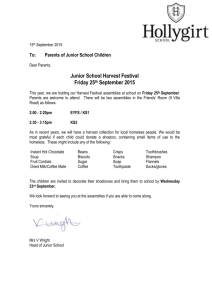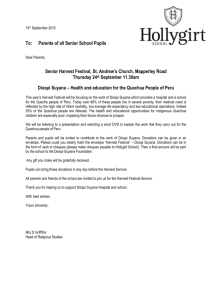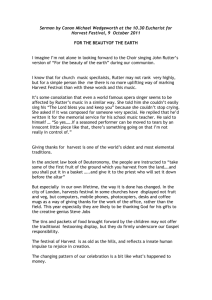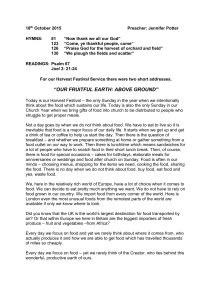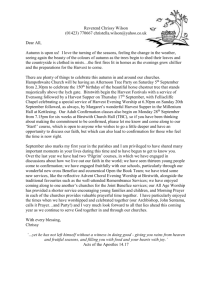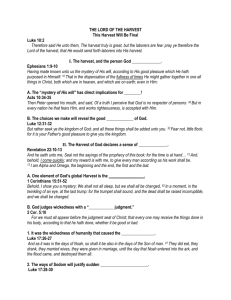TheGoodEarth.doc
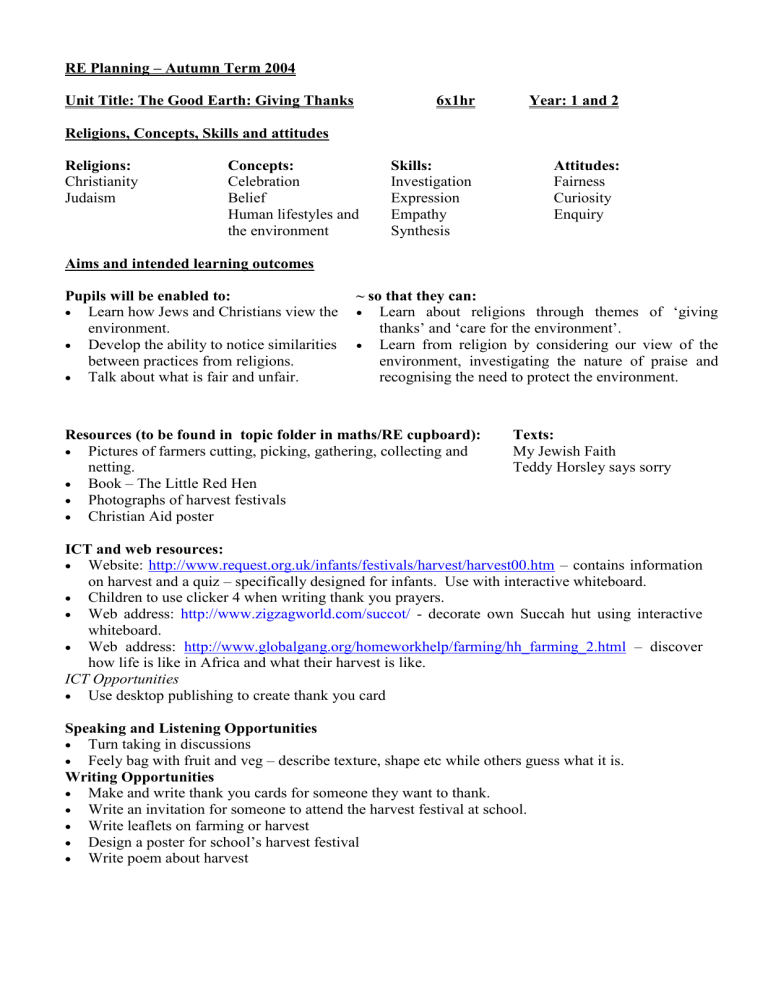
RE Planning – Autumn Term 2004
Unit Title: The Good Earth: Giving Thanks
Religions, Concepts, Skills and attitudes
Religions:
Christianity
Judaism
Concepts:
Celebration
Belief
Human lifestyles and the environment
Aims and intended learning outcomes
Pupils will be enabled to:
Learn how Jews and Christians view the
environment.
Develop the ability to notice similarities between practices from religions.
Talk about what is fair and unfair.
Skills:
6x1hr
Investigation
Expression
Empathy
Synthesis
Year: 1 and 2
Attitudes:
Fairness
Curiosity
Enquiry
~ so that they can:
Learn about religions through themes of ‘giving thanks’ and ‘care for the environment’.
Learn from religion by considering our view of the environment, investigating the nature of praise and recognising the need to protect the environment.
Resources (to be found in topic folder in maths/RE cupboard):
Pictures of farmers cutting, picking, gathering, collecting and
netting.
Book – The Little Red Hen
Photographs of harvest festivals
Christian Aid poster
Texts:
My Jewish Faith
Teddy Horsley says sorry
ICT and web resources:
Website: http://www.request.org.uk/infants/festivals/harvest/harvest00.htm
– contains information
on harvest and a quiz – specifically designed for infants. Use with interactive whiteboard.
Children to use clicker 4 when writing thank you prayers.
Web address: http://www.zigzagworld.com/succot/ - decorate own Succah hut using interactive whiteboard.
Web address: http://www.globalgang.org/homeworkhelp/farming/hh_farming_2.html
– discover how life is like in Africa and what their harvest is like.
ICT Opportunities
Use desktop publishing to create thank you card
Speaking and Listening Opportunities
Turn taking in discussions
Feely bag with fruit and veg – describe texture, shape etc while others guess what it is.
Writing Opportunities
Make and write thank you cards for someone they want to thank.
Write an invitation for someone to attend the harvest festival at school.
Write leaflets on farming or harvest
Design a poster for school’s harvest festival
Write poem about harvest
Lesson 1 – What is ‘harvest’?
Objectives
To investigate and be able to explain where fruit and vegetables come from.
To know and use the term ‘harvest’ with an understanding of it’s meaning.
Activities
Talk about their favourite fruit and vegetable. Children will know that fruit and vegetables come in
different forms - tinned, frozen etc.
Produce a shopping bag full of fruit and vegetables. Choose volunteers to come and put their hand in the bag and make a guess at what they can feel. Slowly reveal a fruit or vegetable at a time and ask children to make guesses at what it is. Encourage description in talking about the fruit or vegetable looks like.
Pass it around the class so the children can talk about the feel and smell of the fruit or vegetable.
Ask them about fruits and vegetables they like or dislike.
Show photographs of farm work and talk about the different things that need to be done when making food. Make links between the farming and fruits and vegetables, so that children understand they are grown and harvested too. Ask the children how we get fish - are they planted and harvested? Develop children’s understanding of the word harvest as 'collecting in'.
Provide several activities for the children to rotate around:
Activity 1 - Provide fruit and vegetables and tinned fruit and vegetables. Ask children to play a matching game where they match the tins to the fruit or vegetable in its natural state.
Activity 2 - Provide a selection of fruit and vegetables and hand lenses. Allow children time to explore the fruit and vegetables close up and to talk about what they find out.
Activity 3 - Children could paint or draw their favourite fruit or vegetable. Slice some of the fruits and vegetables so that children can focus on the inside if they want to.
Activity 4 – Have big letters ‘Harvest’. Children to find, cut and stick pictures of fruit and veg and make collage on letters.
Plenary
Gather the children together and have a fruit and vegetable snack time and read The Little Red Hen, talking about how food is made and the different processes involved.
Talk about what they have found out and interesting things they noticed.
Outcomes
Children can identify fruit and vegetables and know the same fruit or vegetable can come in different forms. They can talk about which fruit and vegetable they like and dislike. Children know that fruit and vegetables grow and need to be harvested. They can describe what happens at harvest.
Resources
A selection of fruit and vegetables, tinned/dried fruit and vegetables, shopping bag.
Painting materials, hand lenses, magazines, glue, scissors. Lesson
Pictures of farmers cutting, picking, gathering, collecting and netting.
Book – The Little Red Hen
Resources needed summary
Lesson 2 – Christian Harvest Festival
Objectives
To know that some Christians like to say thank you to God for the harvest
To be able to reflect on times in their own lives when they want to say thank you.
Activities
?Teddy Horsley book
Ask children for examples of when they say thank you and why. Also ask them how they say
thank you (eg. give flowers, card etc)
Tell them that Christians say prayers to say thank you to God. One time that they like to say thank you to God is when all the food is harvested (collected). They have a Harvest Festival where they say thank you.
Find out about the Christian Harvest Festival by using the interactive whiteboard and looking at the website: http://www.request.org.uk/infants/festivals/harvest/harvest00.htm
which has a quiz as well.
Encourage the children to think about how lucky they are always having lovely food to eat, never being hungry.
Ask the children what they think Christians say thank you for in their prayers at harvest? (rain,
sun so crops grow, for a good harvest etc)
Show them the prayer writing frame. As a class, think of things to thank God for as well as food.
Make a list and then read the prayer through as a class.
AA – Use 'Prayer writing frame' and write their own thank you prayers.
A – Cut, order and stick harvest pictures.
BA – Use sheet ‘Harvest’ and draw own thank you prayers/Use clicker 4 to create simple thank you sentences with pictures and word banks.
Plenary
Share their prayers.
Outcomes
Children can list reasons for saying thank you and ways that we do it. Children will know that a harvest festival is a time for Christians to thank God. Children will know that Christians say prayers to thank God.
Resources
Photographs of harvest festivals
prayer writing frame and food word bank
Harvest pictures to order and stick
‘Harvest’ sheet
Harvest prayer frame
Interactive whiteboard
Assessment cues
Lesson 3 – How does our school celebrate Harvest?
Objectives
To recognise that a festival is a special time of celebration.
To know how the school prepares for and celebrates Harvest.
To be able to explain that Christians thank God by offering food/money to needy people.
Activities
Remind the children about the work they did last lesson on Christian Harvest festivals. Explain that a festival is a time of celebration.
Tell the children that the school will also be having a Harvest festival. Talk about what will happen, where it will happen and when. Talk the children through what happens. Talk about how
the hall will be decorated and remind the children why the celebration is being held; to thank God for food and farmers.
Help children to realise that people thank God by offering food/money to needy people.
Create the class contribution for Harvest – collage, prayers, drama, song, leaflets on farming/harvest, poem, posters
Outcomes
Children understand that a Christian Harvest festival is a special time of celebration. Children can talk about the preparations and events at the school Harvest festival. They know that Christians say thank
. you by giving food/money to needy people.
Lesson 4 – Sukkot
Objectives
To know that Jews also celebrate Harvest and their festival is called Sukkot.
To be able to describe some of the practices at the festival of Sukkot.
Activities
Explain to the children that is not just Christians who celebrate a successful harvest, but that most religions have a festival to celebrate this time. Tell the children that they are going to learn about an Autumn festival celebrated by Jews, called Sukkot.
Show the children some pictures of Sukkot being celebrated and talk through what can be seen.
Tell the children that the festival lasts for 8 days. It reminds the Jews of the protection God gave to the Jewish people during the forty years they spent travelling in the desert. Legend has it that our forefather Abraham sat in his tent, with the flaps of the tent folded up on all four sides, so he could welcome weary wayfarers from every direction...
Tell the children that today Jews build a Succah (hut) in their garden. The roof is made of leaves and branches leaving spaces for the stars to still be seen through it, and the Succah is decorated with fruit, vegetables and flowers. Family meals are eaten in the Succah.
A large Succah is built in the Synagogue so that it is big enough for the whole congregation to eat and drink in after the service. Link this to how food is shared after a Christian Harvest festival.
Use interactive whiteboard to decorate own Succah (click and drag items into the picture). Use web address: http://www.zigzagworld.com/succot
ICT
Outcomes
Children will know that Jews celebrate the festival of Sukkot and will be able to talk about how Jews celebrate the festival. Children will be able to identify things that are the same and different about
Harvest and Sukkot.
Resources
Interactive whiteboard
Lesson 5 – Harvest for others
Objectives
To know that some people don’t have a harvest like ours.
To appreciate the role of Christian Aid in helping people find food and to begin to recognise what they can do to help.
Activities
Why do people say thank you at Harvest time? How do they say thank you?
Recap on the Jewish festival of Sukkot. Talk about what people do at this time and why. Why do people say thank you at this time? How do they say thank you? Consolidate children’s ideas on the similarities and differences between the Christian Harvest and Sukkot.
Talk about times when we say thank you. Who do we thank and why? How do we feel when someone says thank you to us? Ask the children why they think people want to give to help others.
Introduce the idea of giving to God by giving to others.
Look at charity poster of people needing food aid. Talk about how they think the people are feeling and why. Encourage the children to realise how lucky they are to always have food. Ask the children if they have helped others. What did they do and why?
Look at Global Gang website to get perspective on how life is for children in Africa: http://www.globalgang.org/homeworkhelp/farming/hh_farming_2.html
Children could design a poster for a charity, asking us to remember those who are hungry or in need.
A charity poster could be designed using a drag & drop program such as My World
Differentiation: by support/outcome
Outcomes
Children will be able to talk about similarities and differences between Harvest and Sukkot. Children will know some people we should be thankful to. Children will know that some people do not have plenty of food. Resources needed
Resources
Posters of people in other countries
charity posters for food aid
card
colouring materials.
Assessment Opportunities
Teachers might assess this work by setting a task like this...
Draw/paint a picture of a key moment during Harvest and another picture of something that happens at Sukkot and annotate it with key facts, feelings and opinions.
Pupils who can work at level 1 will be able to recount some elements of the Harvest and Sukkot celebrations; recognise some of the practices of Harvest and Sukkot; explore and ask questions about fruit and vegetables; respond to things in the light of their own experiences and recognise that life involves choices between right and wrong.
Pupils who can work at level 2 will be able to identify some religious ideas and practices from Harvest and Sukkot; describe experiences and feelings they share with others and identify what is of value and concern to others.
Pupils who can work at level 3 will be able to describe how some of the key features of the Jewish and
Christian religion are used in the festival of Harvest and Sukkot; make links between beliefs from the two religions; identify how beliefs of what is right and wrong affect behaviour.
Level 1
AT1
I can use pictures to talk about what happens at Harvest and Sukkot
I can recognise a picture of a Succah
I can explain where our food comes from
I can ask questions about fruit and where it has come from
AT2
I can say one thing I am thankful for
I can describe how harvest is different for some people who don’t have much food
I can say what I think about some people not having as much as me to eat
Level 2
AT1
I can talk about the religious idea of thanks and praise behind Harvest and Sukkot
I can identify and name practices from Harvest and Sukkot
I can recognise the similarities and differences between ideas and practices relating to the Christian
celebration of harvest festival and the Jewish festival of Sukkot
I can explain why there are festivals of thanksgiving to God
AT2
I can talk about my how I feel knowing some people don’t have much to eat
I can identify what is important to people
I can explain why some people want to help others at Harvest and Sukkot

